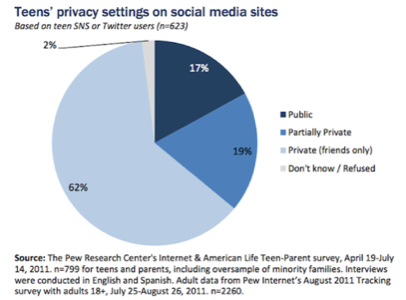Sixty-two percent of teens set their profiles to private (friends only) on social media sites, according to results from a recent study by Pew Internet entitled “Teens, kindness and cruelty on social networking sites.” Nineteen percent set their profiles to partially private, and 17% leave their profiles completely public.

Teens with public profiles tend to have had negative experiences on social media sites. They are nearly twice as likely as those who didn’t have a bad experience to say that their profile was public (23% vs. 12%).

Girls using social media are more likely than boys to say they have restricted their profile to friends only. Of boys, 21% have a profile that’s set to public, compared to 12% of girls.
Teens with partially private profiles say that they do not take additional steps to limit what certain friends can and cannot see, with 84% showing the same thing to all their friends. Only 15% limit which friends can see what.
The report did not go into depth on the variety of Facebook privacy settings, which include basic information (username, gender, profile picture), additional information (networks, likes, activities and interests) and restrictions on individual posts, photos and other content. Pew’s findings suggest that teens are less likely to pay close attention to these site specificities.
Facebook’s privacy settings have a history of changing without much notice. In December 2009, Facebook made users’ name, profile picture, gender, current city, networks, Friends List, and all the pages they subscribed to automatically public. Zuck said the age of privacy was over. All status updates became default public, but users could manually change that setting. In May 2010, Facebook rolled back a bit, allowing users to hide their friends list and their list of interest pages from public view. Users can now customize their default privacy settings with options for public, friends-only, or custom to specific lists. Then Facebook quietly began offering “hide” options for news feed updates. In August 2011, Facebook began offering status updates to specific groups or people.
Of course, with frictionless sharing of music and news on Facebook now, and the eventual rollout of Timeline, privacy will surely shift again. Already users are seeing a raft of information in the news ticker, including those minute details (so-and-so commented on someone’s photo, X is listening to Radiohead on Spotify), that used to appear in the “recent news” portion of the old Facebook News Feed.
The 2011 Teens and Digital Citizenship Survey was sponsored by Pew Research Center’s Internet and American Life Project. The national representative sample included 799 teens ages 12-17 years old. The study also conducted seven focus groups in January and February 2011 with Washington DC metro area teens between the ages of 12 and 19. Fifty-seven youth participated, and the groups were balanced for gender and crossed the socio-economic and family structure spectrum. All teens had a cell phone or computer. Black youth were over-represented in the focus groups.










